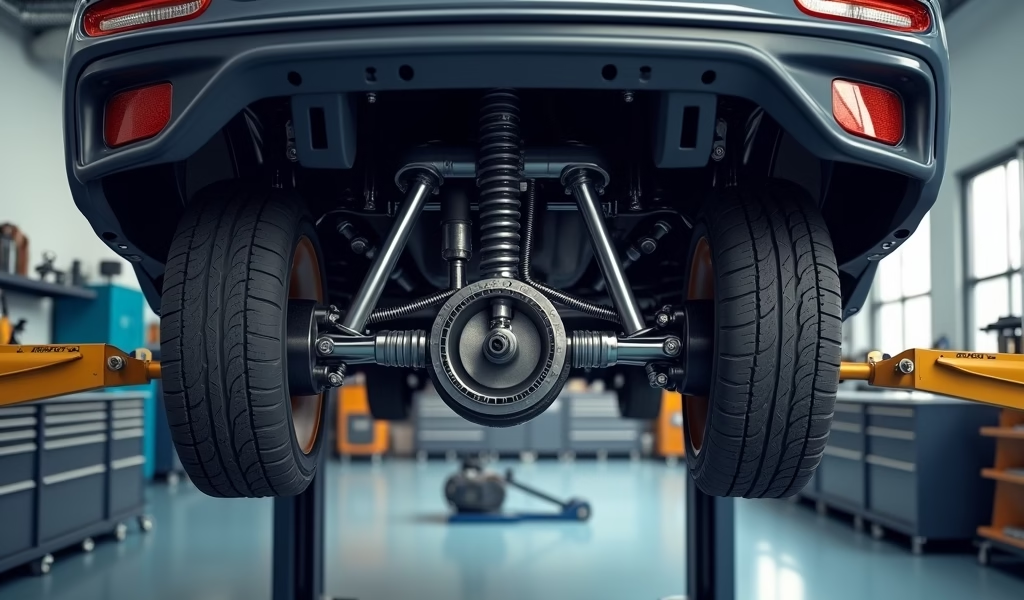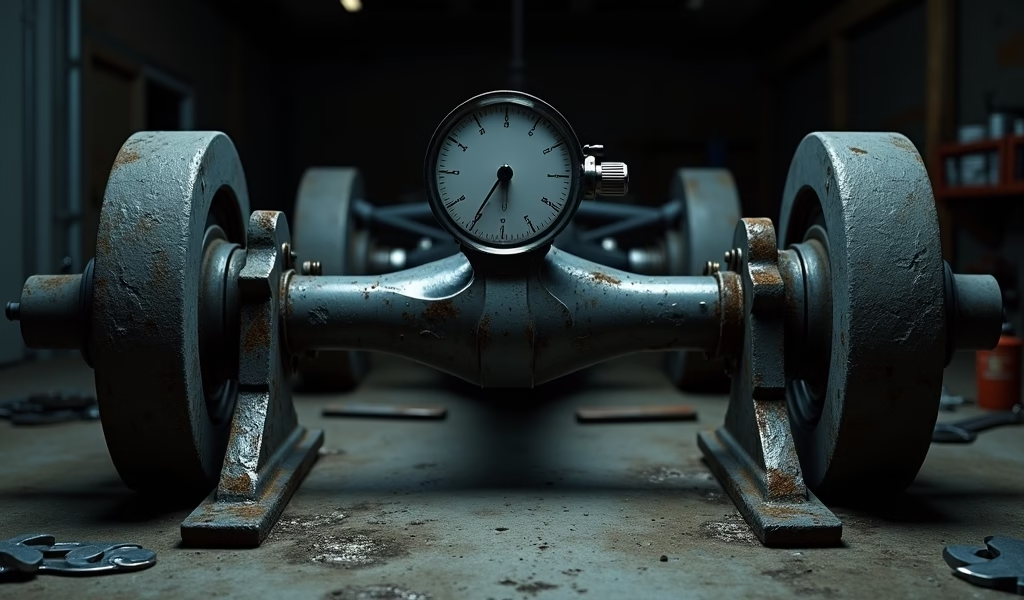Overview
Rear axle housing spread occurs when the distance between bearing bores increases beyond factory specifications, causing problems like unusual noises, vibrations, fluid leaks, and premature wear in vehicle drivetrains. The article explains measurement techniques, DIY fixes for minor spread issues, when to seek professional repair, and preventative measures to maintain proper housing alignment and avoid costly damage to differential components.
Table of Contents
- Understanding Rear Axle Housing Spread: What It Is and Why It Matters
- Common Causes of Rear Axle Housing Spread
- How to Identify Rear Axle Housing Spread Issues
- Proper Measurement Techniques for Rear Axle Housing Spread
- DIY Fixes for Minor Rear Axle Housing Spread
- When to Seek Professional Repair for Housing Spread
- Preventative Measures to Avoid Future Issues
- Conclusion
- Frequently Asked Questions
Understanding Rear Axle Housing Spread: What It Is and Why It Matters
Rear axle housing spread measurement is one of those technical terms that might make your eyes glaze over, but trust me—it’s something every vehicle owner should understand. In simple terms, housing spread refers to the distance between the bearing bores in your rear axle housing. When this measurement isn’t within spec, it can cause all sorts of headaches for your vehicle’s performance and safety.
Think of your rear axle housing like the foundation of a house. If that foundation shifts even slightly, everything built on top of it becomes unstable. The same principle applies here. When the housing spreads beyond manufacturer specifications, your bearings, gears, and other components no longer align properly. This misalignment leads to premature wear, noise, vibration, and in worst cases, complete failure of your differential system.
Most factory axle housings are designed with precise specifications, typically measured in thousandths of an inch. Even a small deviation of 0.005″ to 0.010″ can create noticeable issues in your drivetrain. For performance applications or vehicles that regularly tow heavy loads, maintaining proper housing spread becomes even more critical.
Before we dive deeper into fixes and measurements, it’s worth noting that proper axle housing alignment directly impacts your ring and pinion backlash adjustment, which affects your vehicle’s overall driveability. Let’s explore why this happens and how to address it.
Common Causes of Rear Axle Housing Spread
Housing spread doesn’t just happen overnight. It’s typically the result of accumulated stress or a specific incident. Here are the most common culprits behind this issue:
Excessive torque is often the primary villain. When you launch hard from a stop, especially with sticky tires or on high-traction surfaces, the torque reaction forces the axle tubes to spread apart. This is particularly common in high-horsepower applications or vehicles with significant modifications to the engine or transmission.
Heavy towing puts enormous stress on your rear axle. The constant strain from pulling substantial loads can gradually deform the housing over time, especially if you regularly exceed your vehicle’s rated towing capacity. Even within capacity, years of heavy towing will take its toll.
Impact damage can instantly create housing spread problems. Hitting a large pothole, curb, or experiencing an accident can physically deform your axle housing. The force transfers through your suspension and into the housing structure, potentially altering its crucial dimensions.
Age and fatigue affect even the best-engineered components. Metal fatigue, combined with years of normal driving stress, can cause the housing to weaken and deform gradually. This is especially true for vehicles with high mileage or those operated in harsh conditions.
Manufacturing defects, though less common in quality axles, can sometimes be the root cause. Some housings might leave the factory with dimensions at the outer edge of acceptable tolerances, making them more susceptible to spread issues later in their service life.
According to research from the Society of Automotive Engineers, drivetrain component failures often result from accumulated microstresses rather than catastrophic single events. Understanding these causes helps us better approach both measurement and correction.

How to Identify Rear Axle Housing Spread Issues
Before grabbing your measuring tools, it’s helpful to recognize the symptoms that might indicate a housing spread issue. Your vehicle often gives clear warning signs when this problem develops.
Unusual noises are typically the first indicator. Listen for howling, whining, or rumbling sounds from your rear end, especially during acceleration or deceleration. These noises often result from improper gear mesh patterns caused by housing spread. The pitch might change with speed, which differentiates it from other drivetrain noises.
Vibration that increases with speed frequently accompanies housing spread problems. You’ll feel this through your seats, floorboard, or steering wheel. It occurs because components that should rotate smoothly are now operating at improper angles, creating harmonics throughout the drivetrain.
Differential fluid leaks might become more common. When housing spread occurs, seals that were once perfectly aligned are now under stress, potentially allowing fluid to escape. Check under your vehicle regularly for the telltale reddish-brown spots that indicate gear oil leakage.
Premature or unusual tire wear patterns can signal axle housing issues. If your housing is spread, the wheel alignment is affected, causing tires to wear unevenly. Look for scalloping, feathering, or excessive wear on the inside or outside edges of your rear tires.
Handling problems often develop as housing spread worsens. Your vehicle might feel unstable during cornering or track poorly on straight roads. This happens because the rear wheels are no longer operating at factory-specified angles and positions.
If you notice any combination of these symptoms, it’s time to take measurements to confirm whether housing spread is indeed your culprit. Let’s look at how to do that accurately.
Proper Measurement Techniques for Rear Axle Housing Spread
Measuring rear axle housing spread isn’t something you can eyeball—precision is key. The process requires some specialized tools and careful attention to detail. Here’s how to get it right:
First, gather your tools. You’ll need a housing spreader gauge (sometimes called a bearing bore gauge), dial indicator, and appropriate adapters for your specific axle model. Many professional shops use a specialized tool called a “Spicer bar” that provides accurate measurements between bearing bores.
Preparation is crucial for accurate measurements. Start by thoroughly cleaning the bearing bores and removing any old sealant, dirt, or metal burrs that might affect your readings. A clean surface ensures your measurements reflect the actual housing dimensions, not debris interference.
To measure properly, follow these steps:
- Remove the differential carrier completely from the housing
- Clean all bearing surfaces thoroughly
- Insert the measuring bar through both bearing bores
- Take the measurement using your dial indicator or micrometer
- Compare your readings to the manufacturer’s specifications
Most passenger vehicles and light trucks have specified housing spread measurements in the range of 8.000″ to 9.250″, depending on the axle model. Performance applications might have tighter tolerances. Always consult your vehicle’s service manual or the axle manufacturer for exact specifications.
Keep in mind that differential carrier bearing preload directly relates to housing spread. If your spread is incorrect, you’ll likely struggle to achieve proper preload, leading to premature bearing wear and noise issues.
If you find your measurements are outside specifications, don’t panic. Depending on the severity, there are several approaches to correcting the problem, which we’ll cover in the next sections.
DIY Fixes for Minor Rear Axle Housing Spread
For enthusiasts comfortable with mechanical work, minor housing spread issues can sometimes be addressed at home. Before attempting any repair, ensure you’re dealing with a modest spread problem (typically less than 0.015″ beyond spec) and that no other axle components are damaged.
The most common DIY approach uses a spreader bar and turnbuckle assembly. This method applies controlled force to gradually bring the housing back to specification. Here’s how to proceed:
- Remove the differential carrier completely
- Fabricate or purchase a spreader bar that fits your housing
- Install the bar with a turnbuckle between the bearing bores
- Slowly tighten the turnbuckle while monitoring with a dial indicator
- Once desired measurement is achieved, stop and let the housing “set” for a few hours
- Recheck measurements before reassembly
Shimming is another approach for minor spread issues. Special bearing shims, available from differential specialists, can compensate for slight dimensional issues. While this doesn’t fix the physical spread, it can restore proper bearing preload and gear mesh patterns.
Using aftermarket adjustable bearing supports represents a more advanced solution. These components replace standard bearing caps and allow for fine-tuning of the carrier position. They’re particularly useful for performance applications where precise control over gear mesh is desired.
For those interested in the technical aspects of differential geometry, understanding your final drive axle ratio calculation can help you assess the impact of housing spread on your vehicle’s performance characteristics.
Remember that DIY fixes have their limitations. If your housing spread exceeds 0.020″, or if you notice cracks or severe deformation in the housing, it’s time to consider professional repair or replacement options.

When to Seek Professional Repair for Housing Spread
While DIY solutions work for minor issues, certain situations call for professional intervention. Recognizing when you’re out of your depth can save you time, money, and potential safety hazards down the road.
Severe spread beyond 0.020″ typically requires specialized equipment that most home mechanics don’t possess. Professional shops use hydraulic presses and precision alignment fixtures to restore proper dimensions without risking housing damage. This equipment applies controlled, even force across the housing structure.
When housing spread is accompanied by visible cracks, deformation, or damage to bearing bores, professional assessment is essential. These structural issues compromise the integrity of your entire axle assembly and require expert evaluation to determine whether repair is even feasible.
If you’ve previously attempted DIY repairs without success, it’s time to consult a professional. Repeated unsuccessful adjustment attempts can weaken the housing material and potentially worsen the original problem. A differential specialist can assess the situation with fresh eyes and professional expertise.
According to Randy’s Ring and Pinion Technical Guide, professional repair typically involves:
- Complete disassembly and cleaning of the axle assembly
- Precision measurement using calibrated equipment
- Controlled compression using specialized hydraulic tools
- Heat treatment in some cases to relieve metal stress
- Verification measurements to ensure specifications are met
- Professional reassembly with new bearings and seals
The cost of professional repair typically ranges from $300-$800 depending on the severity of the spread and whether additional components need replacement. While not inexpensive, this investment protects your differential, extends the life of your entire drivetrain, and ensures safe operation of your vehicle.
Preventative Measures to Avoid Future Issues
An ounce of prevention is worth a pound of cure, especially when it comes to rear axle housing spread. Implementing these preventative measures can help you avoid this problem altogether.
Respect your vehicle’s power and towing limits. While it might be tempting to push your truck or car beyond its rated capacities, doing so puts enormous stress on your axle housing. Follow manufacturer guidelines for towing weight and avoid excessive “showing off” with hard launches or burnouts.
Install traction aids wisely. Limited-slip differentials, lockers, and other traction-enhancing devices can dramatically increase torque loads on your housing. If adding these components, consider upgrading to a stronger housing or installing housing spreader brackets simultaneously.
Regular inspection forms your first line of defense. Make checking for fluid leaks, unusual noises, and vibrations part of your maintenance routine. Early detection of minor issues prevents them from developing into major housing spread problems.
If you’ve already experienced housing spread once, consider preventative reinforcement. Aftermarket housing braces and supports can strengthen your axle assembly against future spreading forces. These relatively inexpensive components bolt onto existing housings to provide additional structural rigidity.
For high-performance applications, consider upgraded housings from the start. Fabricated steel housings, often found in racing applications, offer significantly more resistance to spread than cast factory housings. As noted by Motor Trend’s differential guide, these upgraded housings can withstand substantially more torque without dimensional changes.
Remember that proper maintenance of related components—including suspension bushings, shocks, and mounting points—helps distribute forces evenly across your axle assembly, reducing the likelihood of housing spread developing over time.
Conclusion
Rear axle housing spread measurement might seem like a niche concern, but it’s actually a fundamental aspect of vehicle maintenance that affects performance, safety, and longevity. By understanding what housing spread is, recognizing its symptoms, and knowing how to address it, you’re equipped to handle this issue whether you’re a DIY enthusiast or someone who prefers professional service.
Remember that prevention is always easier than cure. Regular inspection, respecting your vehicle’s limits, and addressing minor issues before they worsen will help you avoid the headaches of major housing spread problems. For those already dealing with spread issues, the measurement and correction techniques outlined in this article provide a roadmap to restoration.
Whether you choose DIY methods for minor issues or professional repair for more severe cases, addressing housing spread promptly will extend the life of your differential, improve your driving experience, and potentially save you from costly repairs down the road. Your vehicle’s rear axle is quite literally where the rubber meets the road—keeping it properly aligned ensures you’ll enjoy smooth, trouble-free driving for years to come.
Frequently Asked Questions
What exactly is rear axle housing spread?
Rear axle housing spread occurs when the distance between bearing bores in the axle housing increases beyond factory specifications. This happens due to torque forces, impacts, or wear over time.
How do I know if my vehicle has housing spread issues?
Look for symptoms like unusual differential noises, vibrations, gear oil leaks, or abnormal tire wear patterns. These signs often indicate the housing dimensions have changed from their original specifications.
How much does it cost to fix axle housing spread?
Minor DIY fixes may cost $50-$150 in parts, while professional repairs typically range from $300-$800 depending on severity. Complete housing replacement can exceed $1,200 including labor.
Can I drive with axle housing spread?
While possible in the short term, it’s not recommended as it accelerates wear on bearings, gears, and seals. Severe spread can lead to complete differential failure and potential safety hazards.
Will upgraded aftermarket axles prevent housing spread?
Quality aftermarket housings, especially fabricated steel designs, offer significantly better resistance to spreading forces. They’re a wise investment for high-performance or heavy-duty applications.


Pingback: Axle Tube Straightness Verification 101 - knowsyourcar.com